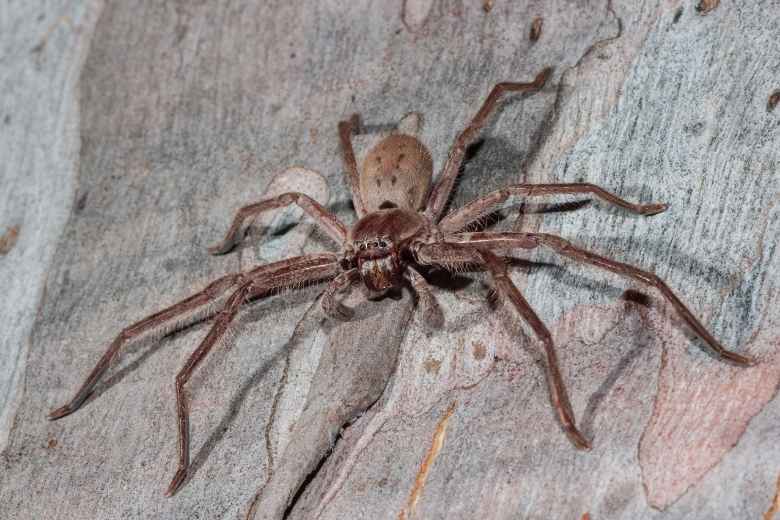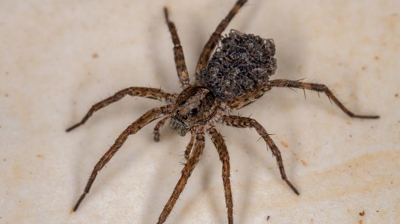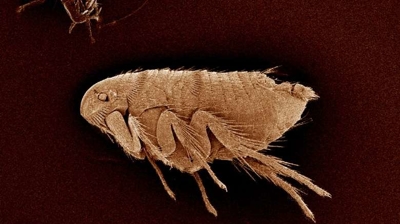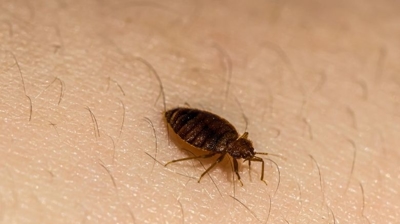
Huntsman Spiders

Are Huntsman Spiders Harmful?
While huntsman spiders are generally not aggressive and are often considered beneficial due to their role in controlling pest populations, there are a few ways in which they might be considered harmful:
- Potential for Bites and Mild Envenomation: Although huntsman spiders are not considered dangerously venomous to humans, they can bite if provoked or threatened, especially if handled directly. Bites from huntsman spiders can cause localized pain, swelling, redness, and in some cases, mild systemic symptoms such as headache, nausea, or dizziness. These reactions are typically mild and self-limiting but can be alarming to those bitten. Some individuals may experience more significant allergic responses, though this is relatively rare. As with any puncture wound, there is also a risk of secondary infection if the bite area is not properly cleaned and monitored.
- Pet and Livestock Concerns: Though rare, there are isolated reports of huntsman spiders biting small animals, especially if they are confined in small enclosures where escape or avoidance is difficult. Cats and dogs may try to play with or eat huntsman spiders, potentially resulting in a bite or minor irritation. Bites to livestock are exceedingly uncommon and usually of no consequence, but the presence of large spiders in barns or feed storage areas may still be unsettling for workers.
- Nuisance Factor in Homes and Businesses: While not destructive in the traditional sense (they don’t chew wires or cause structural damage), huntsman spiders can still be considered a nuisance. Multiple sightings indoors may cause occupants to believe they have a spider infestation, prompting service calls or tenant complaints. In hospitality, food service, or healthcare settings, the sight of a large spider can be damaging to a business's reputation and may raise concerns about cleanliness or safety among customers or inspectors.
- Psychological Impact and Fear Response (Arachnophobia): Huntsman spiders are large, fast-moving, and often found in unexpected places (e.g., behind curtains, inside vehicles, or under furniture). Their sudden appearance can induce intense fear or panic, particularly among individuals with arachnophobia. Their size and speed can trigger a startle response, potentially leading to accidents (e.g., vehicle crashes if a spider appears inside a moving car).
Learn more: Do Huntsman Spiders Bite?
Huntsman Spider Removal
Huntsman spiders are generally not aggressive, but removing them from homes and workplaces is still important for several reasons. Their large size and sudden movements can startle people, which raises the risk of accidents—especially in situations like driving, climbing ladders, or working in tight spaces. They can wedge themselves behind sun visors, curtains, appliances, and other hidden spots, creating surprise encounters that lead to falls or loss of control.
Although their venom isn’t considered medically dangerous, their bite can be painful and may trigger localized swelling or secondary infections. For individuals who are sensitive to spider bites or who have underlying health conditions, even a non-dangerous species can cause unnecessary complications.
Their presence also indicates gaps, cracks, or environmental conditions that may attract other pests. Huntsman spiders often follow insect activity, so seeing them indoors can signal that other pest issues are developing. Keeping the environment free of them typically goes hand-in-hand with maintaining a cleaner, more secure structure overall.
For homes or businesses where customer perception matters, these large visible spiders can create a strong negative impression. Removing them helps maintain a sense of safety and professionalism while reducing stress for occupants who may have a fear of spiders.
Learn more: How To Get Rid Of Huntsman Spiders
Huntsman Spider Control
Hiring our professional pest control for huntsman spiders is highly recommended for several reasons. While huntsman spiders are generally not aggressive toward humans, they can still cause problems that warrant professional attention:
- Accurate Identification and Risk Assessment: Huntsman spiders can sometimes be confused with other larger or more dangerous species, such as the brown recluse or wolf spiders. Our pest control professionals can correctly identify the species, assess potential risks, and determine if treatment is truly necessary.
- Effective and Targeted Treatment: Our professional pest control technicians have access to specialized products and application methods that are far more effective than over-the-counter sprays. We know the spider’s preferred hiding places—under bark, in garages, sheds, behind furniture, and in wall cavities—and can target treatments to reduce infestations efficiently.
- Prevention of Re-infestation: Beyond killing visible spiders, our professionals focus on preventing new huntsman spiders from entering your home. We can seal entry points, treat perimeters, and advise on environmental adjustments (like reducing clutter or outdoor debris) that discourage spider activity.
- Health and Safety Considerations: While huntsman bites are rare and typically cause mild symptoms, some people may experience allergic reactions. Our professionals are trained to handle infestations safely without exposing residents to unnecessary chemicals or risk.
- Time and Stress Savings: Huntsman spiders can move quickly, hide in hard-to-reach areas, and can be intimidating to deal with. Our professionals remove the burden of searching, handling, and treating the infestation yourself, saving you time, stress, and potential mishaps.
- Long-Term Monitoring and Support: A one-time DIY spray may temporarily kill a few spiders but won’t address the larger population or prevent new arrivals. Our professional pest control services include ongoing protective services and inspections to ensure that your home remains spider-free over time.
While huntsman spiders are not usually deadly, our professional pest control approach is the safest, most efficient way to remove them, prevent future infestations, and maintain peace of mind in your home.
Huntsman Spider Exterminators
Choosing our local exterminator over a national provider provides several advantages that become especially important when dealing with fast-moving, elusive pests like huntsman spiders. Our local specialists have a deeper understanding of the micro-environmental conditions unique to the area—things like seasonal spider activity, common entry points in local building styles, and the specific insect populations that attract huntsman spiders indoors. That local insight leads to more accurate inspections and targeted treatments instead of generic, one-size-fits-all protocols.
You also tend to get faster, more responsive service. Our local team schedules more flexibly, arrives sooner, and devotes more time to each property. That matters with huntsman spiders because effective control often requires careful physical removal, detailed sealing work, and follow-up monitoring instead of relying solely on broad chemical treatments. Our local technicians also return promptly if our customers see renewed activity.
Accountability is another major difference. Our local exterminators depend heavily on our reputation within the community, which drives us to communicate clearly, stand behind our work, and customize our approach to each client. National brands often rotate technicians, follow rigid corporate treatment plans, and focus on efficiency rather than personalized results.
Supporting our local team keeps your investment in the community and delivers better value. You get a technician who knows your property, remembers previous service history, and adjusts our strategy to prevent huntsman spiders from returning, rather than just blindly repeating the same standardized service.
Huntsman Spider Solutions
Our exterminators use Integrated Pest Management (IPM) to control huntsman spiders because, while these spiders are generally non-aggressive and beneficial in controlling insect populations, their large size and presence inside homes, garages, or other structures can cause alarm and become a nuisance. IPM begins with a thorough inspection to identify areas of spider activity, potential hiding spots, and environmental conditions that attract them, such as cluttered spaces, dark corners, and abundant insect prey. Management strategies focus on habitat modification by removing clutter, sealing cracks and crevices, controlling insect populations, and improving ventilation and lighting to make areas less hospitable for huntsman spiders. Physical controls, including careful removal and exclusion techniques, help reduce their presence, while chemical treatments are applied selectively and only in high-activity areas. Ongoing monitoring allows our exterminators to track spider populations, evaluate the effectiveness of control measures, and prevent reinfestation. By integrating inspection, habitat management, selective control, and monitoring, IPM provides a long-term, environmentally responsible, and effective approach to managing huntsman spider populations.
What Do Huntsman Spiders Look Like?
Huntsman spiders are known for their distinctive appearance, which includes several key features. Below is a detailed description of what huntsman spiders look like:
- Size: Huntsman spiders are relatively large spiders, with leg spans that can vary from about 1 inch to over 5 inches (2.5 to 13 centimeters) depending on the species. Some individuals can be even larger, making them quite imposing.
- Body Shape: They have a flattened body shape, which is well-suited for squeezing into crevices and tight spaces. This flat body allows them to hide and hunt in narrow gaps and under bark.
- Legs: Huntsman spiders have long, spindly legs that are covered in fine hairs. These legs can be banded or have distinct patterns, depending on the species. The legs are usually longer than the body.
- Coloration: The coloration of huntsman spiders can vary widely, but many species are earth-toned, such as brown, grey, or mottled with shades of these colors. This helps them blend into their natural surroundings.
- Eyes: They typically have eight eyes, arranged in two rows. The posterior row has two large central eyes with smaller eyes positioned around them. The anterior row consists of smaller eyes, which are less noticeable.
- Chelicerae: These are the mouthparts of the spider and can be quite large and conspicuous. The chelicerae contain the fangs, which are used to inject venom into their prey.
- Abdomen: The abdomen of huntsman spiders is generally less flattened than the cephalothorax (the front part of the body), and it can have varying patterns and markings depending on the species.
- Sexual Dimorphism: In some species, males and females may have distinct differences in size and coloration. Males may have longer and more spindly legs, while females tend to be larger and more robust.
The appearance of huntsman spiders can vary significantly between species, and their colors and patterns may help them blend into their specific habitats. While many huntsman spiders are brown or grey, some may exhibit more vibrant colors, depending on their environment and evolutionary adaptations.
Where Are Huntsman Spiders Found?
Huntsman spiders are a diverse group found in various parts of the world, particularly in warm, tropical, and subtropical regions. Here is where you might find huntsman spiders:
- Australia: Australia is known for its diverse huntsman spider species, and they are commonly encountered in homes, gardens, and forests across the country. Some Australian species are quite large and have adapted to urban environments.
- Southeast Asia: Huntsman spiders are prevalent in countries throughout Southeast Asia, including Thailand, Indonesia, Malaysia, and the Philippines. They can be found in both urban and rural areas, often in houses, gardens, and wooded regions.
- Africa: Many African countries are home to various species of huntsman spiders. They are often found in natural habitats, including forests, grasslands, and savannas. They can also be found in and around buildings.
- The Americas: Huntsman spiders are present in parts of the Americas, particularly in regions with warm and humid climates. They can be found in countries like the United States (especially in the southern states), Mexico, Central America, and South America. In the United States, they are more common in states like Florida and Texas.
- Asia and the Middle East: Huntsman spiders are distributed throughout Asia, including countries like India, China, and the Middle Eastern regions. They can be found in diverse environments, from urban areas to rural landscapes.
- Islands and Tropical Regions: Huntsman spiders are also common in many tropical islands and archipelagos. They are often found in rainforests, coastal areas, and other tropical ecosystems.
- Human Habitats: Huntsman spiders are known for their ability to adapt to human settlements. They frequently take up residence in homes, where they may hide in crevices, behind furniture, or in corners of rooms. They are often seen on walls and ceilings, especially at night when they are actively hunting.
- Natural Habitats: In their natural habitats, huntsman spiders can be found in a variety of locations, including under tree bark, in leaf litter, in rock crevices, and in caves. They are skilled hunters that often hide and wait for prey to pass by.
The specific species and prevalence of huntsman spiders can vary by region, and their presence can be influenced by climate, habitat, and local environmental conditions. While huntsman spiders are generally not considered dangerous to humans, their presence in homes can sometimes be a source of concern for those who are not accustomed to these large arachnids.
What Do Huntsman Spiders Eat?
Huntsman spiders are skilled and opportunistic predators, and their diet primarily consists of a wide range of insects and other arthropods. Here is a look at what huntsman spiders eat:
- Insects: Huntsman spiders are adept at hunting various types of insects, including flies, moths, crickets, grasshoppers, and beetles. They often ambush their prey and use their speed and agility to chase down and capture insects.
- Other Spiders: Huntsman spiders are known for cannibalistic behavior, and they will readily feed on other spiders, including smaller or weaker individuals. This can include web-building spiders that they encounter.
- Small Vertebrates: In some cases, larger huntsman spiders have been observed capturing and feeding on small vertebrates like geckos and small lizards. These encounters are relatively rare but demonstrate the versatility of their hunting abilities.
- Arachnids and Myriapods: They also consume other arachnids, such as scorpions and harvestmen, and myriapods, including centipedes and millipedes.
- A Variety of Prey: Their diet can be quite diverse and opportunistic. They are known to feed on whatever prey is available in their environment, which can vary based on location and habitat.
- Nocturnal Predators: Huntsman spiders are primarily nocturnal hunters, meaning they are most active at night when many insects and other arthropods are also active. They use their keen eyesight and hunting strategies to catch prey in the dark.
- Ambush Predators: Huntsman spiders often use a sit-and-wait or ambush hunting strategy. They remain hidden in crevices, under bark, or on walls and ceilings, waiting for unsuspecting prey to pass by. When prey comes within striking distance, they pounce with great speed to immobilize and subdue it.
- Venom and Digestion: Huntsman spiders inject venom into their prey through their fangs, which not only immobilizes the prey but also begins the process of digestion. They then use enzymes to liquefy the internal tissues of their prey, allowing them to suck up the nutrients.
While huntsman spiders are formidable predators, they are generally not considered a threat to humans. In fact, they can be beneficial in controlling insect populations in and around homes. However, their large size and appearance can be intimidating to some people, leading to concerns when they are found indoors.
Huntsman Spider Life Cycle
The life cycle of huntsman spiders follows a typical arachnid life cycle, consisting of several distinct stages from hatching to maturity. Here is an overview of the life cycle of huntsman spiders:
- Egg Stage: The life cycle begins with the female huntsman spider laying eggs. She constructs a silk sac or egg case in which she deposits her eggs. The number of eggs can vary between species but can range from dozens to hundreds.
- Incubation: The female guards the egg sac and may carry it with her, protecting it from predators and environmental threats. During this period, she may become more aggressive in defending her nest.
- Hatching: When the time is right, the spiderlings, or baby huntsman spiders, emerge from the egg sac. They typically hatch within several weeks to a few months, depending on environmental conditions.
- Spiderlings: The spiderlings are very small and delicate when they first hatch. They often remain close to the mother for protection and can resemble miniature versions of adult huntsman spiders. As they grow, they will undergo several molts, shedding their exoskeletons to accommodate their increasing size.
- Juvenile Stage: During this phase, the spiderlings begin to disperse and establish their own territories. They continue to grow, molt, and develop the physical characteristics that are distinctive to adult huntsman spiders. This stage can last for several months to a few years, depending on the species and environmental factors.
- Mature Adults: Once the huntsman spider reaches maturity, it is ready to reproduce. The timing of maturity varies among species and can take one to three years or more. Adult huntsman spiders are known for their size and distinctive appearance.
- Reproduction: Adult males and females seek each other for mating. After mating, the female will lay eggs, beginning the cycle anew. In some species, males may take great risks to approach females, as there is a potential danger of being mistaken for prey.
- Lifespan: The lifespan of a huntsman spider can vary depending on factors like species, environmental conditions, and availability of prey. Typically, huntsman spiders can live for one to two years, but some may have shorter or longer lifespans.
Huntsman spiders are highly adaptable and can thrive in a variety of environments. Their life cycle is influenced by factors such as temperature, humidity, and prey availability. Additionally, their size and behavior can vary between species, and their overall life cycle duration may differ accordingly.

Hear From Our Happy Customers
-
"Fantastic & Patient"
Jarvis was fantastic and patient. He answered my questions with an in-depth explanation and addressed all of my areas of concern. Would love for him to be my assigned tech going forward. Well done!
- Yonnette M. -
"Wonderful Service"
Wonderful service. Jarvis is great. Took care of everything I needed. Thank you!
- Henry P. -
"Great Communication"
Tech was on time, communication was great, and he accommodated my needs.
- Alonzo W. -
"Exceeds Expectations"
I can’t say enough positive things about this company... The tech that came out, Jarvis went above and beyond my expectations. Thank you guys, I will continue using your services.
- Jake M. -
"Very Knowledgeable"
The tech that arrived was courteous, professional, and very knowledgeable. He was Great.
- Uerial I. -
"Professional & Considerate"
I’m pleased with Miche services. Jarvis came today. Professional and considerate. Thank you!
- Judy B.



